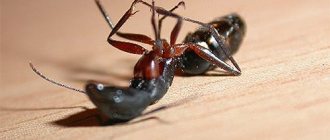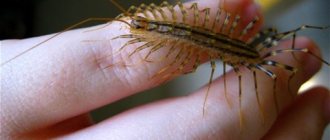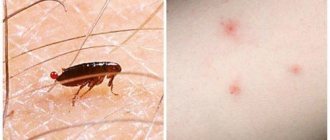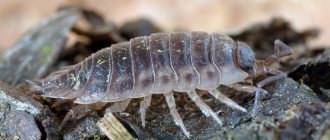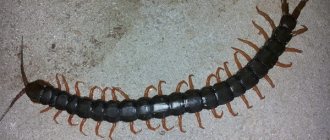There are several effective and fairly easy-to-implement ways to get rid of skin beetles in an apartment. In general, both adult carpet beetles and their larvae do not differ in any increased resistance to insecticides and die even when treated with relatively inexpensive preparations, but only in the case when these preparations manage to treat either the insects themselves or the surfaces on which they often crawl. And since neither skin beetles nor their larvae are particularly mobile, it turns out that the majority of these insects simply hide where they cannot be found and continue to quietly breed.
Adult skin beetle and last instar larva
In our experience, all people who turn to us for a service to remove skin beetles cannot cope with these insects simply because they do not find their main breeding sites. And we ourselves usually have to tinker with such pest control areas to find such places.
And in about half of the cases of such treatments, these places where skin beetles accumulate are, in principle, impossible to reach - the beetles and their larvae are located where you cannot get to either with your hands, much less with a spray bottle. In such cases, only professional equipment or mini-repairs can help.
But first things first.
Destruction of skin beetles in three steps
In the most general case, the destruction of skin beetles is carried out according to the following plan:
- All places where leather beetles hide, breed and feed are searched and opened. This is the most difficult stage, because due to their phenomenal omnivorous nature, these bugs with their larvae can safely exist, grow and reproduce almost anywhere.
- Places where insects accumulate are treated with insecticides.
- Additionally, with preparations with a long residual effect, places where either adult beetles or larvae were regularly encountered, but where they are not permanently present, are treated. Here the calculation is made on the fact that insects that are not in places of accumulation and that can survive the treatment can move along these surfaces. Having come into contact here with a drug with a long residual effect, the insects will die, albeit later than the main part poisoned directly.
Here in the photo, for example, beetles collected in the apartment after disinfestation:
With professional disinfestation, the third stage is not needed - in the second step, all surfaces and possible hiding places of skin beetles are sprayed so intensively that they all die. Even if some individuals survive such baiting, with the slightest subsequent movements they will end up on a layer of the drug, which will remain in those places where the owners of the apartment, even with thorough cleaning, will not be able to remove it - behind the baseboards, on the back walls of furniture, under floor covering. And all these surviving characters will die. Although, according to our observations, no surviving skin beetles remain indoors after proper treatment with professional products.
Let's now go through each point in order.
How to rid your home of midges?
We have all encountered midges at least once in our lives. These harmless creatures can cause significant discomfort and multiply in geometric quantities! Insects love to live in flowers, fruits, vegetables, sweets, for them it is like bait. And to prevent midges from bothering you, first of all you need to remove the source through which their active reproduction occurs. Remove food, look after indoor plants, and do not allow rotten vegetables or fruits to be in a warm room.
Midges are harmless only at first glance, they spread dangerous diseases
You can remove the accumulation of midges on the wall and ceiling using a vacuum cleaner, after which the bag with insects should be shaken out, preferably outside. Baits are usually made for midges, for example, put a piece of rotten fruit in a plastic bag. Once they get in for the treat, the insects will no longer be able to get out. Pour any alcohol into a shallow dish, and in the morning all the midges will remain in the plate. Standard duct tape also works well.
It is easy to get rid of midges by removing the source (flowers, rotten food)
Search for places where skin beetles accumulate and hide in an apartment
This stage is the simplest technically, since it does not involve any complex actions, but it is also the most labor-intensive, since in order to find all the hideouts of skin beetles, you need to:
- Carefully inspect all food supplies. The most preferred food for skin beetles is grocery products, long-stored meat products (sausage, dried fish, semi-finished products), and dried fruits. Very often, accumulations of skin beetle larvae and a large number of the bugs themselves are found in closets, bedside tables and cupboards in the kitchen, as well as behind them, under them and near them. Remember, by the way, that skin beetle larvae quite easily gnaw through plastic bags and climb inside them or get out of them.
- Open and disassemble the sofa, remove mattresses from beds, disassemble bed frames. Very often, skin beetle larvae settle in leather sofas and gnaw their upholstery, or settle under mattresses and feed on the skin that peels off from sleeping people.
- Remove baseboards near beds and closets and inspect the spaces behind them. Microscopic organic particles often accumulate behind the baseboards, as well as the remains of the bodies of other insects - cockroaches, bedbugs, silverfish. All of them are eaten by both skin beetle larvae and beetles.
- If possible, you need to unscrew the edges of the linoleum or carpet on the floor, remove the trim on the frames of interior doors, look behind the peeling wallpaper - there may be leather beetles everywhere.
- If the house has various collections - herbariums, stuffed animals, butterfly exhibits in glass boxes - they all need to be examined. This is the main target for skin beetles, which are known as the scourge of zoological and botanical collections.
The main difficulty in such searches is that leather beetles themselves are not social or colonial insects; they do not need each other at all until they reach adulthood and therefore absolutely calmly crawl throughout the apartment and can be found alone in completely different places. Therefore, often quite complex manipulations with sofas, beds and closets end with the discovery of only 2-3 insects. And to find all the pests, you literally need to turn half the house upside down and dismantle it.
For example, they can sometimes be found in a slipper, where the larvae eat the cotton lining seasoned with the skin that peels off the feet:
However, the most attractive places for skin beetles attract the bulk of individuals living indoors, and here entire clusters of them are usually found, albeit very chaotic.
In addition, in some species of skin beetles, adult individuals are quite small and cannot always be seen from a distance of a meter and a half.
In our treatments, we most often find skin beetles in the following places:
- Leather sofas, including under the upholstery inside the filling.
- Gaps behind baseboards and under parquet.
- Closets.
- Shelves and cabinets on balconies.
- Spaces under cabinets.
Adult bugs very often accumulate on window sills, but usually individuals appear here that have flown from the street onto the balcony.
If any products contaminated with skin beetle larvae are found in the apartment, then it is advisable to throw these products away . Trying to remove insects from them and keep the same cereal, or vermicelli, is too difficult.
Our statistics
We must admit that we very rarely come across apartments with some kind of very strong infestation of skin beetles. In most cases, at most several dozen individuals live in one house or apartment, and in 14 years we have had 5-6 situations where we found hundreds of them in one dwelling. It’s just that even 30-40 leather beetles in a room multiply quite quickly, their beetles come across quite often, and the larvae, due to their high mobility, can be found in various parts of the apartment, which gives the impression that these insects are everywhere here.
Here, in the photo, the edges of the carpet are damaged by carpet beetle larvae
As a rule, if you manage to find 2-3 places where skin beetles accumulate in an apartment, you can consider this a success. The only thing left to do is to etch them here and leave the product in all similar places in the room. Still, there may also be single individuals huddling there, which either could not be noticed, or simply could not get into the cracks in which they are hiding.
Distinctive characteristics
The soldier bug is not the only name for this bug. Due to its unusual coloring (patterns, spots with black dots on a red background), it is also called a fireman. And the absence of hind wings explains the third name - wingless red bug.
The soldier bug looks like an ordinary ground bug with a characteristic pattern on its back.
The size of the bug does not exceed 8-10 mm, and the body has a round, slightly flattened shape. Instead of a mouth, the soldier has a kind of proboscis.
However, only a description of the appearance cannot give a complete description of this bug. It’s not for nothing that they call it a harbinger of spring, because bedbugs with a red back and black stripes are among the first to emerge from their shelters after the winter cold.
Insects carry out their life activities in groups.
Small colonies of firebugs are found in various places:
- near fallen trees.
- Along the fences.
- In woodpiles with firewood.
- Etc.
Striped bugs always cluster on an open surface as close to sunlight as possible.
Bedbugs prepare thoroughly for hibernation, which lasts all winter, by selecting dry cracks in fences, old houses, and tree trunks in advance.
The soldier bug is visually very similar to the firefighter beetle.
Insects can be distinguished by the following characteristics:
- body shape (in a beetle it is more elongated).
- A specific aroma characteristic of bedbugs.
- The ability to fly, which the fire beetle boasts.
The latter protects the plantings from pests, which include the wingless red bug. This type of bed bug appears extremely rarely in an apartment.
How and with what can you destroy discovered insects?
Where leather beetles can be found, they can be destroyed in a variety of ways.
The simplest, most reliable and fastest way is to treat the area of the accumulation with an insecticide solution . Carpet beetles are sensitive to most products that can be used at home; even relatively inexpensive spray cans are effective against them.
According to our observations, skin beetles are most reliably destroyed by preparations based on organophosphorus compounds, which we use to bait bedbugs. Among household drugs, such drugs include Karbofos, Executioner and Forsyth, Get Total. Lambda-cyhalothrin-based products are also very effective (Lambda-Zone, Paragraph), but they must be used with great caution due to their acute effects, including on people and pets.
In principle, skin beetles can be destroyed using a steam generator or steam cleaner. They quickly die under a stream of steam, even if the grain in which they are located is processed with such a stream. Although, it is easier to throw out infected cereals with them than to eradicate insects from it.
It is possible that beetles and their larvae found in places where there are accumulations can be destroyed using folk remedies, but we do not know exactly how effective any of them are. We assume that vinegar or denatured alcohol will kill these insects immediately upon first contact with these products, but in our practice we do not use such folk remedies, since high-quality insecticides are safer, do not stink as much and give a much more reliable result.
In those places where beetles and larvae of leather beetles are found singly, it is easier to simply catch them and crush them with your fingers. It's faster and more reliable. True, these places themselves will definitely need to be treated with an insecticide: if insects ended up here once, then some individuals that survived in the room will probably climb here again. And if poison awaits them here, then this journey through the apartment will be their last.
When we poison bedbugs, we treat with an insecticidal preparation not only the places where skin beetles accumulate and meet, but generally all the surfaces in the room where these insects may be found. This guarantees that after disinfestation, any surface will be a continuous minefield for leather beetles, and even if some insects could not be destroyed immediately, they are guaranteed to die if they try to crawl anywhere.
In addition, continuous spraying allows you to reach skin beetles where they cannot be seen. For example, in the form of a cold mist, the insecticide is blown into narrow cracks behind sliding wardrobes, under laminate flooring, behind non-removable trims and door frames. Here, insects cannot be destroyed manually and they cannot be removed from here by anything, but a fine insecticidal mist is blown in here very effectively and settles on the entire internal surface of such cracks and cavities. Due to this, all insects here are destroyed during the processing itself.
Cold fog treatment
It is almost impossible for the owner of the premises to treat the apartment with a spray bottle on a bottle as tightly as a master does with a cold fog generator. Because of this, you can poison skin beetles yourself only in the most accessible places, and if they hide in places where you can’t get them, then the treatment has to be repeated many times, and it is not always possible to remove skin beetles even after 4-5 such disinsections with your own hands.
That is why, after professional pest control, you can safely forget about skin beetles and not take any further measures, since the professional methods and means themselves guarantee that there will be no more insects in the apartment. And after destroying them on your own, you also need to work on finishing off the individual surviving pests.
Where do little red bugs come from?
Since the wingless red bug is accustomed to a humid and fairly warm climate, its natural habitat can be designated as the tropics and subtropics.
It is difficult to say exactly where red bugs come from in our latitudes. However, due to the peculiarities of their structure, parasites are quite adaptive. Even once they get into a person’s home, they can easily find food for themselves in the form of indoor plants.
To prevent pest infestation of the garden, it is worth cleaning the area in a timely manner. Elimination of rotten stumps and old trees, as well as periodic disinsection, will help get rid of unpleasant parasites.
Prevention of the appearance of surviving bugs and their larvae
In most cases, after baiting, individual beetles, and especially the smallest larvae, almost invisible to the naked eye, can survive in places where they were simply not found and not treated with an insecticide. They can safely remain here, lay eggs, or grow and pupate. And while they are in these inconspicuous places, no one will see them, and the owners of the apartment will think that they are not in the room. But either older larvae, which will exhaust food sources and will be forced to crawl away in search of new ones, or beetles, which will look for mating partners, will sooner or later get out of these shelters and begin to catch the eye.
Our experience
According to reviews and surveys of our clients, after disinfestation, no one encountered a single skin beetle in the house for 4 months. Of the 413 treatments that we carried out against these insects, 6 people (1.5%) met single individuals six months to a year after disinfestation, and it is impossible to say with confidence whether these were insects that survived the persecution, or new ones that entered the apartment after extermination. Be that as it may, in all six cases, single individuals were caught, which were easily destroyed by hand. There was no talk of any mass reproduction of skin beetles in the apartment after such persecution.
The photo below shows an unfolded litter with a whole cluster of skin beetle larvae:
At a minimum, to passively destroy them, it is enough to sprinkle all the cracks behind the baseboards, the joints of the edges of the flooring and the bottom of the walls in the room with some insecticidal powder. Hector or Ecokiller are suitable for this - they retain their effectiveness as long as they remain dry, and behind the same baseboards they will kill leather beetles a month, two, and six months after they are poured here.
It is enough to simply kill all the beetles that come into view after this, and the larvae with your own hands. After thorough baiting, there should not be many of them left in the room, and this way you can manually kill off all the surviving pests.
Who is he
If you have at least once encountered a small black or brown bug in your apartment, and more than one, you should definitely read this article carefully. It is likely that a leather beetle has settled in your house. If, having heard its name, you decided that this small insect feeds exclusively on skin, then you are very mistaken. Unfortunately, there are very few things that are inedible for these nasty insects. Glue, fabric, cardboard, food products - this is not a complete list of “goodies” that such bugs will be happy to try. With the same success, they will not disdain products made of wood, plastic and even concrete. Therefore, if you suddenly find such a “little animal” in your home, you need to get rid of it urgently.
Processing rules
The drugs used to treat the house are very strong and can harm household members.
To avoid possible negative consequences, you must follow a number of rules:
- All inhabitants of the house, including animals , must leave it during disinfection.
- When spraying poison , windows and doors should be tightly closed, and the walls should be free of furniture.
- After finishing the treatment , the one who carried out it must also leave the house for several hours.
- After the house has been disinfected , all rooms should be thoroughly ventilated and cleaned, but you should only wash those places that you touch with your hands, so that there are few chemicals left for the larvae that may appear.
- Repeated treatment can be done no earlier than after 14 days.
Removal sequence
Skin beetles must be removed in the correct sequence:
- First you need to find their habitat . There may be several of them, so it is necessary to carefully examine every corner of the house.
- The next step should be general cleaning . You should try to collect as many parasites as possible with a vacuum cleaner. The vacuum cleaner bag should be shaken out very vigorously, or simply thrown away. It’s also good if you have a water vacuum cleaner, then the pests will definitely not run away after cleaning.
- After cleaning, you can begin disinfestation . It must be done very carefully and try to get to all possible crevices in order to completely get rid of the beetles.
- After treating the house, you need to monitor the possible appearance of insects and, if skin beetles are detected again, disinfection must be repeated.
Behavioral features
Females mate and begin laying eggs in May. During its life, an individual lays more than 4,000 larvae. Before turning into an adult insect, the larva goes through 6 stages of molting.
For good development, warmth, humidity, and availability of food are necessary. The first small caterpillars emerge from the eggs two weeks after laying. The break between molts, depending on the temperature, is up to 9 days. The skin beetle larva spends all this time searching for food and absorbing what it finds. She never sleeps. Before pupation, the larva is able to gnaw through passages up to 10 cm in length. The passages are hopelessly damaged expensive things that cannot be returned to their original condition.
With enough food throughout the year, the larva develops into an adult. But if there is a shortage of food, it does not die, but simply freezes. Suspension in development up to 5 years is possible.
A characteristic feature of behavior is extreme mobility. Every second the caterpillar wriggles, bends, jumps, wriggles, overcomes obstacles with enviable agility, and, sensing danger, accelerates its motor activity. Active movement is observed when a small worm is forced to develop new routes in search of food. If a comfortable place with food is found, the creature only eats and rests in between, remaining in a state of rest.
Skin beetle caterpillars are afraid of bright light. They have an amazing appetite. During the entire period of development, they will damage your property.
Preventive measures
To prevent skin beetles from infesting your apartment, it is worth periodically performing preventive measures. To do this, twice a year you need to go through all the things and clothes that are stored in closets. Old products are thrown away so that they do not linger.
As a preventive measure, it is allowed to use special tablets with the following odors:
- lavender;
- sagebrush;
- tansy;
- camphor;
- tobacco.
The leather beetle can cause enormous damage to property and the apartment itself. Accordingly, it is necessary to treat the premises using effective means. These can be special tablets or aerosols. If there are too many pests, you will have to call a disinfection service.
How to deal with the leather beetle
Danger to humans
The leather beetle that has settled in your apartment would be much more harmless if it only harmed interior items and personal belongings, but, unfortunately, this beetle can also harm human health. There is no scientific evidence that leather beetles can bite humans, but these beetles still bite people. The bite of a skin beetle is impossible not to notice, it is very unpleasant and painful, pink spots remain after the bite, and in some people the wounds begin to bleed. A skin beetle bite can be contagious to humans. The beetle infects you with worms (helminths). It's not fatal, but still very unpleasant. If you are nevertheless bitten by a skin beetle, do not scratch the bite site under any circumstances; treat the wound with what you usually use to treat insect bites. You can buy an antihistamine at the pharmacy. Visit your doctor to get tested for infections.
How to correctly “calculate and defeat” the skin beetle



